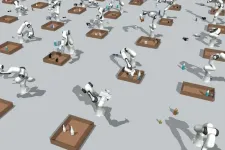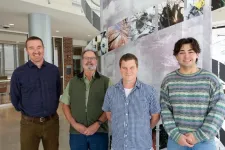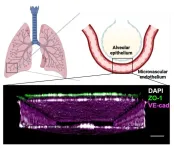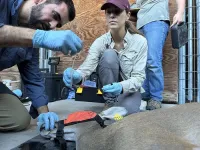(Press-News.org) CAMBRIDGE, Mass. -- Anyone who has ever tried to pack a family-sized amount of luggage into a sedan-sized trunk knows this is a hard problem. Robots struggle with dense packing tasks, too.
For the robot, solving the packing problem involves satisfying many constraints, such as stacking luggage so suitcases don’t topple out of the trunk, heavy objects aren’t placed on top of lighter ones, and collisions between the robotic arm and the car’s bumper are avoided.
Some traditional methods tackle this problem sequentially, guessing a partial solution that meets one constraint at a time and then checking to see if any other constraints were violated. With a long sequence of actions to take, and a pile of luggage to pack, this process can be impractically time consuming.
MIT researchers used a form of generative AI, called a diffusion model, to solve this problem more efficiently. Their method uses a collection of machine-learning models, each of which is trained to represent one specific type of constraint. These models are combined to generate global solutions to the packing problem, taking into account all constraints at once.
Their method was able to generate effective solutions faster than other techniques, and it produced a greater number of successful solutions in the same amount of time. Importantly, their technique was also able to solve problems with novel combinations of constraints and larger numbers of objects, that the models did not see during training.
Due to this generalizability, their technique can be used to teach robots how to understand and meet the overall constraints of packing problems, such as the importance of avoiding collisions or a desire for one object to be next to another object. Robots trained in this way could be applied to a wide array of complex tasks in diverse environments, from order fulfillment in a warehouse to organizing a bookshelf in someone’s home.
“My vision is to push robots to do more complicated tasks that have many geometric constraints and more continuous decisions that need to be made — these are the kinds of problems service robots face in our unstructured and diverse human environments. With the powerful tool of compositional diffusion models, we can now solve these more complex problems and get great generalization results,” says Zhutian Yang, an electrical engineering and computer science graduate student and lead author of a paper on this new machine-learning technique.
Her co-authors include MIT graduate students Jiayuan Mao and Yilun Du; Jiajun Wu, an assistant professor of computer science at Stanford University; Joshua B. Tenenbaum, a professor in MIT’s Department of Brain and Cognitive Sciences and a member of the Computer Science and Artificial Intelligence Laboratory (CSAIL); Tomás Lozano-Pérez, an MIT professor of computer science and engineering and a member of CSAIL; and senior author Leslie Kaelbling, the Panasonic Professor of Computer Science and Engineering at MIT and a member of CSAIL. The research will be presented at the Conference on Robot Learning.
Constraint complications
Continuous constraint satisfaction problems are particularly challenging for robots. These problems appear in multistep robot manipulation tasks, like packing items into a box or setting a dinner table. They often involve achieving a number of constraints, including geometric constraints, such as avoiding collisions between the robot arm and the environment; physical constraints, such as stacking objects so they are stable; and qualitative constraints, such as placing a spoon to the right of a knife.
There may be many constraints, and they vary across problems and environments depending on the geometry of objects and human-specified requirements.
To solve these problems efficiently, the MIT researchers developed a machine-learning technique called Diffusion-CCSP. Diffusion models learn to generate new data samples that resemble samples in a training dataset by iteratively refining their output.
To do this, diffusion models learn a procedure for making small improvements to a potential solution. Then, to solve a problem, they start with a random, very bad solution and then gradually improve it.
For example, imagine randomly placing plates and utensils on a simulated table, allowing them to physically overlap. The collision-free constraints between objects will result in them nudging each other away, while qualitative constraints will drag the plate to the center, align the salad fork and dinner fork, etc.
Diffusion models are well-suited for this kind of continuous constraint-satisfaction problem because the influences from multiple models on the pose of one object can be composed to encourage the satisfaction of all constraints, Yang explains. By starting from a random initial guess each time, the models can obtain a diverse set of good solutions.
Working together
For Diffusion-CCSP, the researchers wanted to capture the interconnectedness of the constraints. In packing for instance, one constraint might require a certain object to be next to another object, while a second constraint might specify where one of those objects must be located.
Diffusion-CCSP learns a family of diffusion models, with one for each type of constraint. The models are trained together, so they share some knowledge, like the geometry of the objects to be packed.
The models then work together to find solutions, in this case locations for the objects to be placed, that jointly satisfy the constraints.
“We don’t always get to a solution at the first guess. But when you keep refining the solution and some violation happens, it should lead you to a better solution. You get guidance from getting something wrong,” she says.
Training individual models for each constraint type and then combining them to make predictions greatly reduces the amount of training data required, compared to other approaches.
However, training these models still requires a large amount of data that demonstrate solved problems. Humans would need to solve each problem with traditional slow methods, making the cost to generate such data prohibitive, Yang says.
Instead, the researchers reversed the process by coming up with solutions first. They used fast algorithms to generate segmented boxes and fit a diverse set of 3D objects into each segment, ensuring tight packing, stable poses, and collision-free solutions.
“With this process, data generation is almost instantaneous in simulation. We can generate tens of thousands of environments where we know the problems are solvable,” she says.
Trained using these data, the diffusion models work together to determine locations objects should be placed by the robotic gripper that achieve the packing task while meeting all of the constraints.
They conducted feasibility studies, and then demonstrated Diffusion-CCSP with a real robot solving a number of difficult problems, including fitting 2D triangles into a box, packing 2D shapes with spatial relationship constraints, stacking 3D objects with stability constraints, and packing 3D objects with a robotic arm.
Their method outperformed other techniques in many experiments, generating a greater number of effective solutions that were both stable and collision-free.
In the future, Yang and her collaborators want to test Diffusion-CCSP in more complicated situations, such as with robots that can move around a room. They also want to enable Diffusion-CCSP to tackle problems in different domains without the need to be retrained on new data.
“Diffusion-CCSP is a machine-learning solution that builds on existing powerful generative models,” says Danfei Xu, an assistant professor in the School of Interactive Computing at the Georgia Institute of Technology and a Research Scientist at NVIDIA AI, who was not involved with this work. “It can quickly generate solutions that simultaneously satisfy multiple constraints by composing known individual constraint models. Although it’s still in the early phases of development, the ongoing advancements in this approach hold the promise of enabling more efficient, safe, and reliable autonomous systems in various applications.”
This research was funded, in part, by the National Science Foundation, the Air Force Office of Scientific Research, the Office of Naval Research, the MIT-IBM Watson AI Lab, the MIT Quest for Intelligence, the Center for Brains, Minds, and Machines, Boston Dynamics Artificial Intelligence Institute, the Stanford Institute for Human-Centered Artificial Intelligence, Analog Devices, JPMorgan Chase and Co., and Salesforce.
###
Written by Adam Zewe, MIT News
Paper: "Compositional Diffusion-Based Continuous Constraint Solvers"
https://arxiv.org/pdf/2309.00966.pdf
END
New technique helps robots pack objects into a tight space
Researchers coaxed a family of generative AI models to work together to solve multistep robot manipulation problems
2023-10-17
ELSE PRESS RELEASES FROM THIS DATE:
Mitochondrial protein plays key role in glioblastoma and therapeutic resistance
2023-10-17
Glioblastoma is the most common type of brain tumor that affects adults and, unfortunately, still remains incurable. In a new study, researchers have demonstrated that a specific mitochondrial protein plays an important role in glioblastoma, and can therefore be used as a potential target to reduce tumors.
“Glioblastoma is notorious for its lethality. One of the major challenges is that it spreads invasively throughout the brain. We’re interested in understanding what drives this process in order to identify new therapeutic strategies,” said Brendan Harley (RBTE leader/EIRH), the Robert W. Schaefer Professor of Chemical ...
Whaling wiped out far more fin whales than previously thought
2023-10-17
Key takeaways
Whaling in the 20th century destroyed 99% of the Eastern North Pacific fin whale breeding population.
Because there is enough genetic diversity, current conservation measures should help the population rebound without becoming inbred.
The future of fin whales in the Gulf of California depends on the recovery of the Eastern North Pacific population.
A new genomic study by UCLA biologists shows that whaling in the 20th century destroyed 99% of the Eastern North Pacific fin whale breeding, or “effective,” population — 29% more than previously thought.
But there is also some good news: Genes among members of this endangered ...
Human Lung Chip leveraged to faithfully model radiation-induced lung injury
2023-10-17
By Benjamin Boettner
(Boston) — The lung is one of the tissues most sensitive to radiation in the human body. People exposed to high radiation doses following nuclear incidents develop radiation-induced lung injury (RILI), which affects the function of many cell types in the lung, causing acute and sustained inflammation, and in the longer term, the thickening and scarring of lung tissue known as fibrosis. RILI also is a common side effect of radiation therapy administered to cancer patients to kill malignant cells in their bodies, and can limit the maximum radiation dose doctors can use to control their ...
Texas A&M receives over $1 million in USDA grants to study SARS-CoV-2 in deer
2023-10-17
Texas A&M University scientists and research partners have received two National Institute of Food and Agriculture (NIFA) Agriculture and Food Research Initiative (AFRI) grants to study the spread of SARS-CoV-2 in deer. These funds will help researchers understand the impact of the virus in Texas’ deer populations and its relationship to human and ecological health.
For these projects, the research team will focus on captive deer, which are an agricultural species in Texas, including managed deer that live on large, rural properties enclosed by fences, as well as on the wild deer with which captive deer may interact and deer living ...
SwRI develops novel solution to advance synthesis for nerve agent antidotes
2023-10-17
SAN ANTONIO - October 17, 2023 — Southwest Research Institute has developed a unique technology (US20230242487A1) that enables the safe and efficient synthesis of organophosphorus nerve agent (OPNA) oxime antidotes. Using this technology, SwRI scientists can not only successfully synthesize currently known highly effective nerve agent countermeasures, but also effectively develop promising new drug candidates to treat nerve agent exposure.
Current treatments for OPNA exposure have not changed significantly since the 1950s. OPNAs are odorless and colorless chemicals ...
The Foundation for Angelman Syndrome Therapeutics to advance gene therapy candidate through IND-enabling studies conducted in partnership with the University of Pennsylvania
2023-10-17
October 17, 2023—The Foundation for Angelman Syndrome Therapeutics (FAST) announced today that the non-profit organization has entered into an exclusive global collaborative research and development agreement with the University of Pennsylvania to develop an investigational adeno-associated virus (AAV) gene therapy for Angelman syndrome (AS).
Angelman syndrome is a nondegenerative neurogenetic disorder that is estimated to impact approximately 1 in 15,000 births, or potentially 500,000 individuals world-wide, ...
Harnessing molecular power: electricity generation on the nanoscale
2023-10-17
WASHINGTON, Oct. 17, 2023 – Wave energy technology is a proven source of power generation, but there is power inherent in every molecule of liquid on earth, even when the liquid is at rest. At the molecular scale, atoms and ions are always moving. If this nanoscale movement can be harvested, it could be a big source of energy.
“There are vast amounts of air and liquid on the earth, and their successful harvesting could produce a gigantic amount of energy for society,” author Yucheng Luan said.
In an article published this week in APL Materials, by AIP Publishing, Luan and his collaborators tested a molecular energy harvesting device that captures ...
Study reveals our European ancestors ate seaweed and freshwater plants
2023-10-17
For many people seaweed holds a reputation as a superfood, heralded for its health benefits and sustainability, but it appears our European ancestors were ahead of the game and were consuming the nutrient-rich plant for thousands of years.
Researchers say they have found “definitive” archaeological evidence that seaweeds and other local freshwater plants were eaten in the mesolithic, through the Neolithic transition to farming and into the Early Middle Ages, suggesting that these resources, now rarely eaten in Europe, only ...
Effects of the million hearts model on heart attacks, strokes, and Medicare spending
2023-10-17
About The Study: The Million Hearts Model, which encouraged and paid health care organizations to assess and reduce cardiovascular disease (CVD) risk, reduced first-time heart attacks and strokes. The results support guidelines to use risk scores for CVD primary prevention.
Authors: Laura Blue, Ph.D., of Mathematica in Washington, D.C., is the corresponding author.
To access the embargoed study: Visit our For The Media website at this link https://media.jamanetwork.com/
(doi:10.1001/jama.2023.19597)
Editor’s Note: Please see the article for additional ...
Climate network analysis helps pinpoint regions at higher risk of extreme weather
2023-10-17
WASHINGTON, Oct. 17, 2023 – Climate change and the rapid increase in frequency of extreme weather events around the globe – such as wildfires and floods – reinforces the reality that these events are not only not random but, rather, interconnected. Interlinked climate behavior, or teleconnections, isn’t a well understood field but will be necessary to fully comprehend how our climate system works.
In Chaos, from AIP Publishing, a team of researchers affiliated with Beijing Normal University and Beijing University of Posts and Telecommunications in China and the Potsdam Institute for Climate Impact Research in Germany describes a climate network analysis method to explore ...
LAST 30 PRESS RELEASES:
S-species-stimulated deep reconstruction of ultra-homogeneous CuS nanosheets for efficient HMF electrooxidation
Mechanical and corrosion behavior of additively manufactured NiTi shape memory alloys
New discovery rewrites the rules of antigen presentation
Researchers achieve chain-length control of fatty acid biosynthesis in yeast
Water interactions in molecular sieve catalysis: Framework evolution and reaction modulation
Shark biology breakthrough: Study tracks tiger sharks to Maui mating hub
Mysterious iron ‘bar’ discovered in famous nebula
World-first tool reduces harmful engagement with AI-generated explicit images
Learning about public consensus on climate change does little to boost people’s support for action, study shows
Sylvester Cancer Tip Sheet for January 2026
The Global Ocean Ship-Based Hydrographic Investigations Program (GO-SHIP) receives the Ocean Observing Team Award
Elva Escobar Briones selected for The Oceanography Society Mentoring Award
Why a life-threatening sedative is being prescribed more often for seniors
Findings suggest that certain medications for Type 2 diabetes reduce risk of dementia
UC Riverside scientists win 2025 Buchalter Cosmology Prize
SETI Institute opens call for nominations for the 2026 Tarter Award
Novel theranostic model shows curative potential for gastric and pancreatic tumors
How beige fat keeps blood pressure in check
Fossils reveal ‘latitudinal traps’ that increased extinction risk for marine species
Review: The opportunities and risks of AI in mental health research and care
New map reveals features of Antarctic’s ice-covered landscape
Beige fat promotes healthy vascular function and blood pressure in mice
Chronic low-dose pesticide exposure reduces the life span of wild lake fish, China-based study shows
Tiny earthquakes reveal hidden faults under Northern California
Long-term pesticide exposure accelerates aging and shortens lifespan in fish
Professor Tae-Woo Lee's research group develops groundbreaking perovskite display technology demonstrating the highest efficiency and industry-level operational lifetime
The “broker” family helps tidy up the cell
Ecology: Mummified cheetahs discovery gives hope for species’ Arabic reintroduction
Researchers survey the ADHD coaching boom
Air pollution and cardiac remodeling and function in patients with breast cancer
[Press-News.org] New technique helps robots pack objects into a tight spaceResearchers coaxed a family of generative AI models to work together to solve multistep robot manipulation problems






